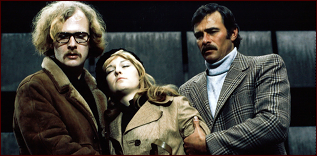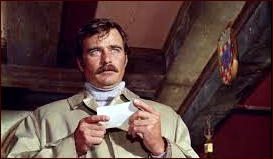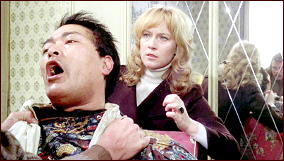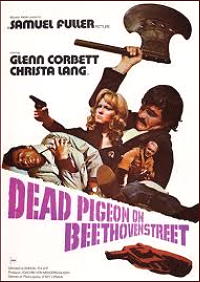Tue 20 Jun 2017
A Made-for-German-TV Movie Review: DEAD PIGEON ON BEETHOVEN STREET (1973).
Posted by Steve under Crime Films , Reviews[7] Comments

DEAD PIGEON ON BEETHOVEN STREET. Episode 25, Season 1, of Tatort, Germany, 07 January 1973. Original title: Tote Taube in der Beethovenstraße. Glenn Corbett, Christa Lang, Sieghardt Rupp, Anton Diffring, Stephanie Audran, Eric P. Caspar. Screenwriter-director: Sam Fuller. Novelization: Dead Pigeon on Beethoven Street, by Samuel Fuller (Pyramid V3736, paperback original, 1974).
This is the story of a private eye named Sandy (Glenn Corbett) who comes to Germany on an extremely important case. He’s been hired an United States senator with presidential aspirations to obtain a negative that in the wrong hands could prove to be extremely embarrassing. His partner, who arrived before him, is dead. His objective: find the killer, infiltrate the gang of blackmailers, and save the senator’s hide.

The killer, as it turns out, is a fellow named Charlie Umlaut. Sandy’s gateway to the gang is a girl named Christa (Christa Lang) who is also the girl in the compromising photograph. She also knows who the leader of the gang is (Anton Diffring), and to gain her confidence, Sandy poses as a rival in the blackmail business. But can Christa herself be trusted, even when propinquity (between herself and Sandy) takes the way of nature and least resistance?
This was filmed at a low point in Director Sam Fuller’s career. The story had nothing (or very little) to do with the rest of the German series it was filmed as part of. But Fuller had name value, and he was given a a free hand, more or less — given budgetary considerations. The movie (which is what I will call it) is filmed in beautiful colors and fanciful camera angles, and in those two regards, I should consider it a huge success.

But the story, at least in the longer, restored director’s cut (in the DVD recently released and remastered through the UCLA Archives) becomes repetitious and boring, and the acting is stiff and the dialogue on occasion seemingly ad-libbed. Christa Lang’s awkward body motions, speech patterns and facial expressions can easily become annoying, if you allow them. (She was married to Fuller at the time and until his death.)
Some reviewers have really disliked this movie. Others call it a work of genius, calling it an inspired collision with (and combination of) Noir and the New Wave. I don’t know as I’d go that far, but Fuller usually knew what he was doing, and while I also don’t know if he did here, maybe he really did. Either that or the movie is a complete failure, and once that is admitted, then perhaps that’s what it was how it was intended, as a complete spoof of the crime genre.
And maybe this review makes sense too, and maybe it doesn’t.

June 20th, 2017 at 2:05 pm
I enjoyed Dead Pigeon on Beethoven Street when I saw it 40 years ago, at the campus film society. No masterpiece, it has interesting set pieces and a sense of fun. Also some good German location work.
Didn’t know about the longer restored version. Sounds interesting.
I always thought Fuller’s movies were all carefully scripted by him. Have never considered they might include ad libs or improvisation.
Glenn Corbett had previously starred in one of Fuller’s best films,”The Crimson Kimono”.
June 20th, 2017 at 7:56 pm
I still have my copy of Fuller’s 1974 novel version. Never read it. It’s a Pyramid paperback.
My favorite of Fuller’s novels is “Crown of India” (1966). It’s reportedly based on his screenplay for a film never produced.
Are Steve and I the only people who’ve seen Dead Pigeon?
Before today, I would have said it was better known than half of the films reviewed here at Mystery*File. Now I’m not so sure!
June 21st, 2017 at 2:03 pm
It’s tough to find a movie reviewed here that none of the regular commenters have never seen before, but it can be done. Some of Dan Stumpf’s favorite cult classics might fall into that category, and David Vineyard may have stumped everyone with his recent Sherlock Holmes in China review.
But as later comments have come in and shown, while not one of Fuller’s better known works, Mike, you and I aren’t the only ones to have seen it!
June 20th, 2017 at 8:46 pm
I enjoy the film despite its flaws, and because Fuller does try to do something with the film that is worth seeing.
Fuller’s novels are a mixed bag. I liked CROWN OF India, but really admired SCANDAL SHEET and THE BIG RED ONE.
June 20th, 2017 at 9:14 pm
I thought Fuller’s finest film, by far, was Park Row, which was done on a low budget with Gene Evans in the lead. And he was just great, as was everything else.
June 21st, 2017 at 3:38 am
I read Fuller’s book, and saw the film on commercial television maybe 30 years ago. My impression was that both were enjoyable but not his best.
June 21st, 2017 at 8:55 pm
Barry,
I”ll second PARK ROW as his best.